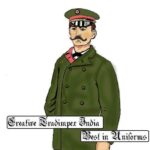he Allure of the Military Tunic: A Style Inspired by the Meiji Era and Beyond
The striking uniform in the photograph, with its sharp tailoring, high scarlet collar, and bold gold accents, immediately evokes a sense of history, discipline, and prestige. While it resembles a Japanese Meiji-era uniform, it’s more accurately described as a modern ceremonial jacket that draws its powerful aesthetic from a pivotal time in global military history. Let’s delve into the fascinating world of the uniforms that inspired this style, particularly those of Meiji Japan.
A Glimpse into the Past: The Uniform’s Design
The jacket in the image is a masterclass in military-inspired design. Key features include:
- A High, Stand-up Collar: Known as a Mandarin or Nehru collar, this feature was popular in military tunics of the late 19th century. The vibrant red color, or “facing,” traditionally denoted a specific regiment or branch of service.
- Dark Tunic Body: The deep black or navy blue wool provides a stark, authoritative background for the colorful and metallic embellishments.
- Gilded Embellishments: The row of shining brass buttons and the distinct trio of gold stripes on the cuffs are hallmarks of a dress or parade uniform. In historical contexts, such stripes, known as “chevrons” or “service stripes,” would signify an officer’s rank and years of service.
- Red Epaulettes: The red shoulder pieces further enhance the uniform’s ceremonial appearance, often serving as a platform for rank insignia.
While these elements are historically inspired, the crisp fabric and modern cut of the jacket in the photo suggest it is a contemporary piece—likely a ceremonial, band, or formal-wear uniform, rather than a historical artifact. However, its inspiration is clearly rooted in the 19th century, a period when Japan was undergoing a dramatic transformation.
The Meiji Restoration: A New Uniform for a New Army
The user’s association of this uniform with the Meiji era (1868-1912) is insightful, as this period was defined by Japan’s rapid modernization and adoption of Western technology, culture, and, notably, military fashion.
Before the Meiji Restoration, samurai warriors wore traditional armor, or yoroi. However, as Emperor Meiji consolidated power and built a modern, conscripted national army, the military’s attire was completely overhauled to reflect Western models.
Initially, the Imperial Japanese Army (IJA) adopted uniforms influenced by the French, featuring dark blue tunics and kepi-style hats. By the 1880s, a shift towards a more German, specifically Prussian, model became evident. This led to the adoption of the Model 1886 uniform, which bears the closest resemblance to the style seen in the photograph. This uniform consisted of:
- A dark blue, single-breasted tunic with a high, standing collar.
- Collar patches and shoulder insignia in branch colors (red for infantry, for example).
- Trousers and a peaked cap.
This dark blue dress uniform, with its stark colors and rigid structure, was designed to project the power, discipline, and modernity of the new Japanese state. It was worn during a critical period of Japan’s emergence onto the world stage, including the First Sino-Japanese War (1894-1895).
By the Russo-Japanese War (1904-1905), the practicalities of modern warfare had led to the adoption of khaki field uniforms, but the dark, ornate dress uniforms remained for ceremonial occasions, forever cementing the image of the high-collared officer in the historical consciousness.
Conclusion: An Enduring Symbol
The jacket in the photograph is a powerful symbol. While not a direct historical replica of a specific Meiji-era uniform, it beautifully captures the spirit of that transformative age. It speaks to a time when military dress was a potent statement of national identity and ambition. This style, echoing the parade grounds of Prussia, the battlefields of Meiji Japan, and the ceremonial halls of modern armies, continues to command respect and admiration for its timeless elegance and authority.




Magnificent goods from you, man. I’ve understand your stuff
previous to and you are just extremely fantastic.
I actually like what you have acquired here, really like what you are stating and the way in which you say it.
You make it enjoyable and you still take care of to keep
it sensible. I can’t wait to read much more from you. This is actually a terrific site.